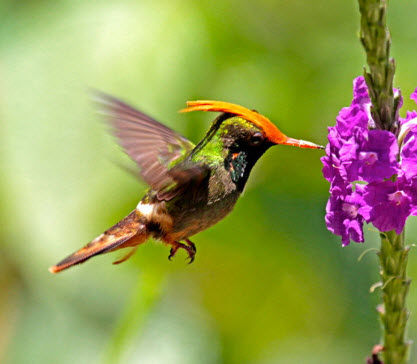Panama has always interested us as a country because it has more recorded bird species than any other Central American country. To give you a sense of perspective, Panama, about the size of South Carolina, has recorded close to 980 species, more than are found in all of the United States and Canada. Also of interest is the Panama Canal, one of the greatest engineering feats of modern history.
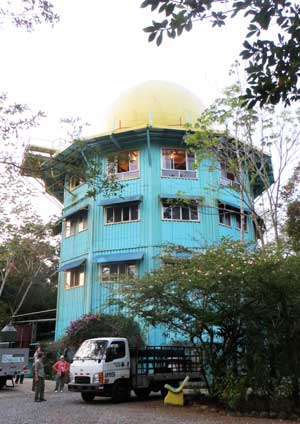
Canopy Tower. (Photos by David Durrant)
All of this led us to plan a trip to Panama. In preparation for the trip, as a Christmas gift, Pam gave David “The Birds of Panama: A Field Guide” and David McCullough’s “The Path Between the Seas.” Both books were daunting: The field guide had illustrations, descriptions, and range maps of 978 species, and McCullough’s book was more than 600 pages.
David started with McCullough’s book, a fascinating history of the development of the canal with wonderful descriptions of the technical challenge of building it. It was well worth the read during our trip as we continually encountered areas described in the book and were able to see firsthand some of the immense technical challenges that the builders had encountered.
A challenging field guide
The field guide was more of a challenge. Although David recognized most of the bird families from previous trips to Belize, Costa Rica, and Guatemala, the sheer numbers in each family were a challenge to learn. There are more than 20 species of hummingbirds—here we have one, the ruby-throated hummingbird—and more than 40 species of flycatchers, while we have a chance of seeing maybe 12 in our area.
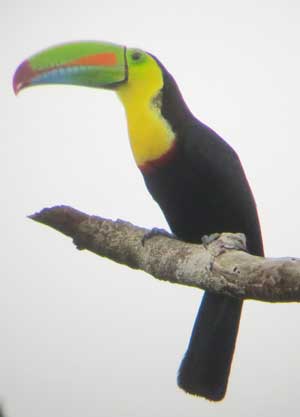
A keel-billed toucan.
Panama’s avian diversity is due in part to its location at the intersection of two continents, North and South America, and its diverse topography. Panama has around 117 endemic species (birds found only in that country).
In years of reading about Panama, we had found one destination constantly mentioned— Canopy Tower. It’s a radar dome erected during the Cold War by the United States on a high point, Semaphore Hill, between Panama City and Colon. It was decommissioned several years ago and was bought by an enterprising Panamanian birder who turned it into a birding destination. Surrounding the old radar dome, above the canopy of the rain forest, is an observation deck where one can look down at canopy birds and see raptors at eye level. It’s a nice break from being on the ground, where you are craning your neck to see the birds in the 80- to 100-foot trees.
We found that Canopy Tower had a sister facility in the Darien province, which is on the eastern border of Panama and Colombia, and we decided to spend our first week at what is called Canopy Camp.
Panama City
We flew into Panama City and spent two days there before heading off to the camp. Panama City surprised us by being a lot bigger than we had imagined, with dozens of new skyscrapers and lots of architecturally interesting buildings. We learned that Panama City is home to about two million of the four million people who live in Panama. We found a nice hotel in the old part of the city, which we enjoyed exploring with trips to Frank Gehry’s Biomuseo and the famous fish market and walks around the harbor. A trip up Ancon Hill just outside the city gave us panoramic views of the city, the harbor with dozens of enormous container ships lined up to go through the canal and the first two locks where two gigantic car carriers were making their way through.
The most numerous birds in the city were grackles, noisy parrots in the trees in the park outside our hotel, and hundreds of black vultures and turkey vultures wheeling overhead.
Canopy Camp
Two days in the city were enough for David, and the next day our guide picked us up for the six-hour drive to the Darien. The trip was broken up with a walk on the Nusagandi Road, where the most interesting birds were the white-tailed trogon, broad-billed motmot, keel-billed toucan, and chestnut-mandibled toucan, which the guides called “a flying banana.”
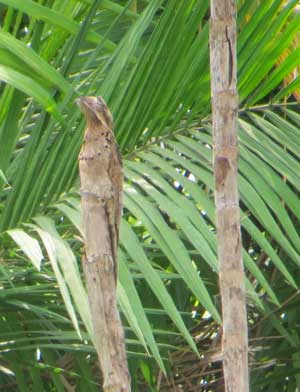
A common potoo, camoflaged in a tree, is hardly noticed.
We saw four different species of woodpecker, the most spectacular being the crimson-crested woodpecker, which is a little smaller than our pileated but with a much larger crimson crest.
Brown-headed and blue-headed parrots flew around with their unmistakable calls. We saw birds with interesting names like paltry tyrannulet, long-tailed tyrant, masked tityra, buff-throated saltator, and plain xenops. We saw six species of tanagers that day but not the summer tanager or scarlet tanager that summer here.
We stopped for lunch at a local restaurant in Torti where we counted eight species of hummingbirds at the feeders hanging around the terrace where we ate. Ending the day at the camp, we recorded having seen 67 species of birds that day.
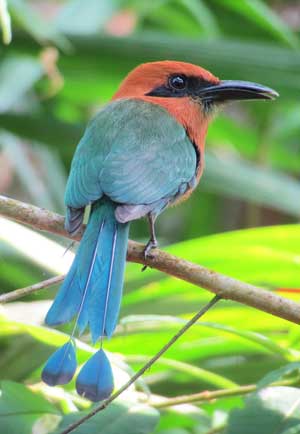
A broad-billed motmot.
Canopy Camp is “off grid” and consists of eight African safari–type tents on wooden platforms and a central open-dining lounge area. Luckily for us there were only two other guests, making the birding with Mojo, our guide, particularly enjoyable. Days consisted of getting an early breakfast on the open-dining terrace, leaving for a three- to four-hour birding trip, returning for a delicious lunch, taking a siesta, going out again around 3 p.m., and then returning for a shower and a relaxed dinner during which we recorded our bird count for the day—not a bad way to live!
Sitting outside our tent at night was amazing. There were more stars than either of us had ever seen, probably because the area was so remote that there was absolutely no light pollution. The tents were completely open but screened; we didn’t encounter any mosquitoes, as it was the dry season. Nights were spent lying in bed listening to the owls, howler monkeys, and various other nocturnal animals.
‘What do you see?’
During our first day there, we birded around the camp and up the mile-long access road. The first bird we saw was a wood stork gliding over some open land, followed by a capped heron. This is one of the most spectacular herons and one we had wanted to see. It was just a flyby but a nice start to birding the Darien. Several days later we would get much better views of this bird perched.
Mojo was an incredible birder and spotted birds that we would have walked by. Walking down the road, he suddenly stopped, set up his scope, and said, “What do you see?” He had focused on a dead stump about 100 feet away. At first we saw nothing, but then the top of the stump moved and two large eyes were looking at David: a common potoo. This nocturnal insect-eating bird perches by day and turns itself into a stump!
